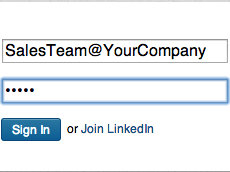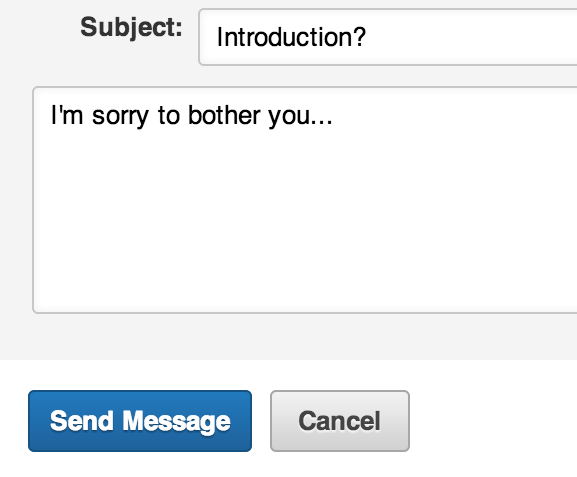 My mind is still trying to process all of the new content – the lessons and introductions and inspiration – it gained from Monday’s Sales 2.0 Conference in Boston. But the trouble is, it just can’t get past one statistic: Less than 15 percent of respondents in an Introhive study of B2B sales professionals said they use LinkedIn when it comes to leads.
My mind is still trying to process all of the new content – the lessons and introductions and inspiration – it gained from Monday’s Sales 2.0 Conference in Boston. But the trouble is, it just can’t get past one statistic: Less than 15 percent of respondents in an Introhive study of B2B sales professionals said they use LinkedIn when it comes to leads.
Rob Begg, the VP of Marketing at Introhive, shared that statistic during a session on why relationships matter. He introduced the conversation by saying that 55 percent of sales professionals believe social media has no effect on their sales efforts at all.
Following these stats, I attempted to justify my shock – maybe I needed to remove my marketing-tinted glasses, or tame my tendency to be overly optimistic, given that it seemed to extend even into my views on social media.
But then my mind went back to Detroit and how many of my team members’ monitors constantly display LinkedIn. Do they find real value in it? I decided to find out.
I started with LevelEleven account executive Rich Starkey, counting on his 15 years of sales experience to offer a well-rounded view. I asked if when he wants to supplement the business development team’s leads by finding some of his own, he relies on LinkedIn. “Where else would I go?” he responded.
My conversations didn’t differ with the rest of the team. In fact, they provided so many recent examples of progressing prospecting opportunities through LinkedIn that I compiled this list of those I found most interesting:
1. Co-workers have college friends, too.
Five – that’s how many times Karley Hall, one of our business development managers, attempted to reach a prospect. Zero is how many times she received a response.
Then she looked up the prospect on LinkedIn and saw a connection with someone on our team. They turned out to be old college buddies, which can offer some of the best opportunities for new business connections. (Who doesn’t enjoy a reminder of their glory days in the middle of a workday?)
That person on our team wrote a fun email to the prospect, joking: “Hey, I heard you were dodging my co-worker’s phone calls and emails – what’s up with that?” A $20,000 opportunity was born.
2. Mom may be connected.
 Brendan Hartt, one of our account executives, specifically looks at his family’s LinkedIn connections from time to time. He recently found that one prospect had a connection to his uncle. This offered him the opportunity to craft a message subject line that most wouldn’t refuse to open:
Brendan Hartt, one of our account executives, specifically looks at his family’s LinkedIn connections from time to time. He recently found that one prospect had a connection to his uncle. This offered him the opportunity to craft a message subject line that most wouldn’t refuse to open:
“ [Prospect’s Name], how do you know [Uncle’s Name]?”
He started the first sentence of the email – the portion which would typically display with that email in the prospect’s inbox – with: “I came across your profile on LinkedIn and saw that you’re connected to my uncle…”
Brendan has his second call with that prospect today.
3. 12 meetings, one week.
Last week, 80 percent of the demos that Karley booked were with people she followed up with on LinkedIn after unresponsive calls and emails. She relies on LinkedIn to inspire responses like these, because it allows prospects to assign a face to her name, adding more of a human element to her communications.
As for the messages, they usually say something like:
“I reached out to you earlier and wanted to introduce myself. I would love to tell you about our app for Salesforce. I noticed on your profile that you were endorsed for Salesforce, so I thought this would be applicable to you.”
4. It’s always nice to meet a fellow Company A alum.
One of Rich’s favorite LinkedIn techniques includes searching the connections of a prospect for anyone who has worked at a company where he has also worked.
If he finds one, he sends that person a message like this:
“I know we don’t know each other, but it’s always nice to connect with former [Old Company Name] alum. What you’re doing at [New Company Name] looks cool, and I’d love to learn more about it and see if we can help each other.”
Last time he did this, it led to the new contact introducing him to a prospect, which then led to a demo.
5. It’s not who you know – it’s who you ask.
 When French motivational speaker David Laroche spoke at Monday’s conference, one of his key takeaways was to not be afraid of asking for what you want. Karley’s also good at that.
When French motivational speaker David Laroche spoke at Monday’s conference, one of his key takeaways was to not be afraid of asking for what you want. Karley’s also good at that.
She may not know all of her LinkedIn connections well, but Karley’s not afraid to ask any of them politely for introductions. Even she gets surprised at how often this creates new opportunities.
Karley usually starts out such messages by saying something like, “I’m sorry to bother you, but I saw that you were connected to A at Company B, and I’ve been trying to get in touch with someone there.”
The last response she received started with: “You’re not bothering me…” and ended with the introduction requested.
On one hand, I feel slightly better in that my team conversations validated my shock around that less-than-15 percent using LinkedIn. On the other hand, it escalates my confusion. If a tool can offer such easy access to prospects, why don’t more sales professionals leverage it?
We’d love to see your thoughts below…




Kristy,
So glad to hear that the Sales 2.0 conference led you to test some of the ideas that were shared by the presenters. As you have discovered, smart salespeople are using LinkedIn as a sales channel. I think we should keep it a secret so that we can enjoy traveling on this information highway that accelerates our sales while our competition is waiting for a call back or a return email. 🙂
Gerhard